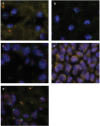Contribution of 1p, 19q, 9p and 10q Automated Analysis by FISH to the Diagnosis and Prognosis of Oligodendroglial Tumors According to WHO 2016 Guidelines
- PMID: 28030632
- PMCID: PMC5193469
- DOI: 10.1371/journal.pone.0168728
Contribution of 1p, 19q, 9p and 10q Automated Analysis by FISH to the Diagnosis and Prognosis of Oligodendroglial Tumors According to WHO 2016 Guidelines
Abstract
Objective: To study the feasibility and the diagnostic and prognostic interest of automated analysis of 1p, 19q, 9p and 10q status by FISH technique in oligodendroglial tumors.
Methods: We analyzed a retrospective series of 33 consecutive gliomas with oligodendroglial histology (originally diagnosed as 24 oligodendrogliomas and 9 oligoastrocytomas). For all cases, automated FISH analysis of 1p, 19q, 9p and 10q status were performed and compared to clinical and histological data, ATRX, IDH1R132H and alpha-internexin status (studied by immunohistochemistry) and overall survival (OS). Manual analysis of 9p and 10q status were also performed and compared to automated analysis to verify the concordance of the two methods.
Results: The 33 gliomas were reclassified into 13 low-grade oligodendrogliomas (OII), 10 anaplastic oligodendrogliomas (OIII), 3 diffuse astrocytomas (AII), 3 anaplastic astrocytomas (AIII) and 4 glioblastomas (GBM) according to the WHO 2016 histological criteria. The 1p and/or 19q imbalanced status were restricted to astrocytomas with no correlation to their grade or their OS. Chromosome 9p deletion was restricted to OIII (70%) and GBM (100%) and was correlated with a shorter OS in the total cohort (p = 0.0007), the oligodendroglioma cohort (p = 0.03) and the astrocytoma cohort (p = 0.001). Concordance between 9p manual and automated analysis was satisfactory (81%, κ = 0.69). Chromosome 10q deletion was restricted to GBMs (50%) and was correlated with a poor OS in both the total cohort (p = 0.003) and the astrocytoma (AS) cohort (p = 0.04). Concordance between manual and automated analysis was satisfactory (79%, κ = 0.62).
Conclusion: Automated analysis of 1p, 19q, 9p and 10q status by FISH is a reliable technique which allows for refined classification of oligodendroglial tumors. 1p and/or 19q imbalanced status is evidence of astrocytic differentiation. 9p deletion is found in high grade oligodendrogliomas and astrocytomas with a poor OS. 10q is related to GBM status and a poor OS.
Conflict of interest statement
The authors have declared that no competing interests exist.
Figures


References
-
- Louis DN, Perry A, Reifenberger G, von Deimling A, Figarella-Branger D, Cavenee WK et al. The 2016 World Health Organization Classification of tumors of the central nervous system: a summary. Acta Neuropathol. 2016;5: 429–435. - PubMed
MeSH terms
LinkOut - more resources
Full Text Sources
Other Literature Sources
Research Materials

